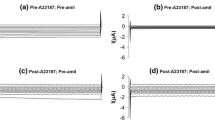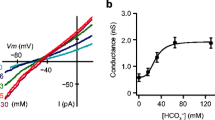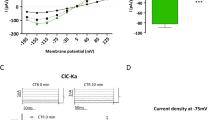Summary
We evaluated the effects of vawrying aqueous Cl− concentrations, and of the arginyl- and lysyl-specific reagent phenylglyoxal (PGO), on the properties of Cl− channels fused from basolaterally enriched renal medullary vesicles into planar lipid bilayers. The major channel properties studied were the anion selectivity sequence, anionic requirements for, channel activity. and the efects of varying Cl− concentrations and/or PGO on the relation between holding voltageV H -mV) and open-time probability (P o).
Reducingcis Cl− concentrations, in the range 50–320mm, produced a linear reduction in fractional open time (P v) with a half-maximal reduction inP o atcis Cl−≈170mM. Channel activity was sustained by equimolar replacement ofcis Cl− with F−, but not with impermeant isethionate. Fortrans solutions, the relation between Cl− concentration andP 0 at 10mm Cl−. Reducingcis Cl− had no effect on the gating charge (Z) for channel opening, but altered significantly the voltage-independent, energy (δG) for channel opening.
Phenylglyoxal (PGO) reducedZ and altered δG for Cl− channel activity when added tocis, but nottrans solutions, Furthermore, in the presence ofcis PGO, reducing thecis Cl− concentration had no effect onZ but altered δG. Thus we propose thatcis PGO and,cis Cl− concentrations affect separate sites determining channel activity at the extracellular faces of, these Cl− channels.
Similar content being viewed by others
References
Bayliss, J.M., Reeves, W.B., Andreoli, T.E. 1990. Cl− transport in basolateral renal medullary vesicles: I. Cl− transport in intact vesicles.J. Membrane Biol. 113:49–56
Breuer, W. 1989. Characterization of chloride channels in membrane visicles from the, kidney outer medulla.J. Membrane Biol. 107:35–43
Catterall, W.A. 1988. Structure and function of voltage-sensitive ion channels.Science 242:50–61
Cohen, F.S. 1986. Fusion of liposomes to planar bilayers.In: Ion Channel Reconstitution. C. Miller, editor. pp. 131–138. Plenum, New York
Garty, H., Yeger, O., Asher, C. 1988. Sodium-dependent inhibition of the epithelial sodium channel by an arginylspecific reagent.J. Biol. Chem. 263:5550–5554
Greger, R., Oberleithner, H., Schlatter, E., Cassola, A.C. 1983. Chloride activity in cells of isolated perfused cortical thick ascending limbs of rabbit kidney.Pfluegers Arch. 399:29–34
Hebert, S.C., Andreoli, T.E. 1984. Effects of antidiuretic hormone on cellular conductive pathways in mouse medullary thick ascending limbs of Henle: II. Determinants of the ADH-mediated increawses in transepithelial voltagre and in net Cl− absorption.J. Membrane Biol. 80:221–233
Kremer, A.B., Egan, R.M., Sable, H.Z. 1980. The active site of transketolase. Two arginine residues are essential for activity.J. Biol. Chem. 255:2405–2410.
Lundblad, R.L., Noyes, C.M. 1984. Chemical Reagnents for Protein Modificantion. Vol. II. pp. 1–47, CRC Press, Boca Raton (FL)
Molony, D.A., Reeves, W.B., Hebert, S.C., Andreoli, T.E. 1987. ADH increases apial Na+, K+, 2Cl− entry in mouse medullary thick ascending limbs of Henle.Am. J. Physiol. 252:F177-F187
Mueller, P.L, Rudin, D.O., Titien, H., Wescontt, W.C. 1962. Reconstitution of excitable cell membrane structure in vitro.Circulation. 26:1167–1174
Ramsey, J.A., Brown, R.H.J., Croghan, P.C. 1955. Electrometric titration of chloride in small volumes.J. Exp. Biol. 32:822–829
Reeves, W.B., Andreoli, T.E. 1990. Cl− transport in basolateral renal medullary vesicles: II. Cl− channels in planar lipid bilayers.J. Membrane Biol. 113:57–65
Reeves, W.B., McDonald, G.A., Mehta, P., Andreoli, T.E. 1989. Activation of K+ channels in renal medullary vesicles by cAMP-dependent protein kinase.J. Membrane Biol. 109:65–72
Reeves, W.B., Winters, C.J., Andreoli, T.E. 1990. Cl− chanels in renal medullary vesicles: Asymmetric dependence on Cl− concentrations.Kidney Int.37:570
Takahashi, K. 1968. The reaction of phenylglyoxal with arginine residues in proteins.J. Biol. Chem. 243:6171–6179
Tanifuji, M., Sokabe, M., Kasai, M.. An anion channel of sarcoplasmicreticulum incorporated into planar lipid bilayers: Single-channel behavior and conductance propeties.J. Membrane Biol. 99:103–111
Yamamoto, D., Suzuki, N. 1987., Blockage ochloride channels by HEPES buffer.Proc. R. Soc. London B 230:93–100
Author information
Authors and Affiliations
Rights and permissions
About this article
Cite this article
Winters, C.J., Reeves, W.B. & Andreoli, T.E. Cl− channels in basolateral renal medullary memnbranes: III. Determinants of single-channel activity. J. Membrain Biol. 118, 269–278 (1990). https://doi.org/10.1007/BF01868611
Received:
Revised:
Issue Date:
DOI: https://doi.org/10.1007/BF01868611




